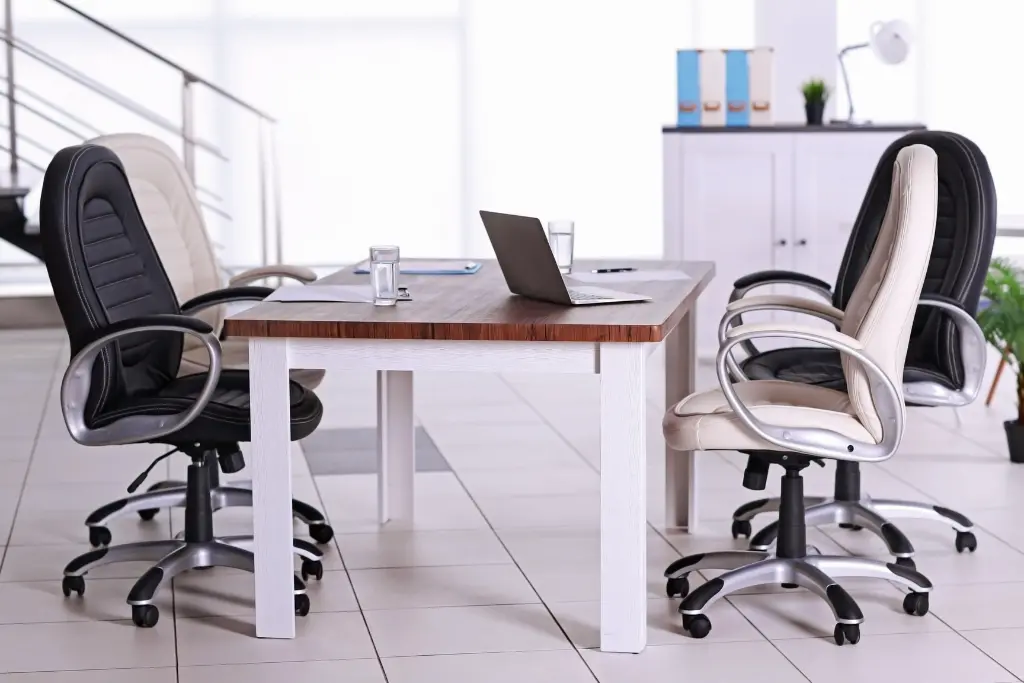Sitting in an uncomfortable office chair for 8 hours a day can leave you feeling drained and sore. So when it’s time to pick a new chair, it’s important to know what to look for in an office chair. A high-quality ergonomic chair will support your back and keep you feeling good all day long. In this article, we’ll cover the most important features to consider like adjustability, back support, seat comfort and more so you can find the perfect chair for your needs and workstation.
Comfort and Support
Comfort is one of the most important things to look for in an office chair. You’ll be sitting in it for hours at a time so you want a chair that feels good. Look for thick, cushioned seats and backs that will prevent pressure points and keep you feeling supported.
The seat should be at least 19 inches wide to accommodate different body types. Wider seats allow you to shift positions without feeling restricted. Seats should also have a waterfall edge for better circulation to the thighs.
As for back support, look for contoured lumbar support in the lower back area. This will keep your spine aligned whether sitting upright or reclined. Adjustable lumbar support is even better so you can customize it to your natural curve.

Do some test sitting and try reclining the chair back. You want a chair that evenly distributes your weight and prevents sliding forward or feeling like you might fall backward. Armrests should also be padded and 4D adjustable so you can raise, lower, extend and pivot them for optimal ergonomics based on your desk setup.
Overall comfort and support are crucial to preventing fatigue, backaches and other issues from long periods of sitting still. Don’t skimp on cushioning, contours and adjustability – your body will thank you after sitting all day!
Adjustability
As everyone’s body dimensions and work style are unique, a highly adjustable chair is important. Features to look for include adjustments for seat height, seat depth, backrest height, tilt tension and possibly even lumbar support height.
Seat height adjustment allows you to situate yourself at the desk in a neutral posture with feet flat on the floor and elbows at a 90-degree angle. Backrest height adjustment complements this to support the natural curve of your back.
Related: How to Adjust Office Chair Seat Angle – An Ultimate Guide
Seat depth adjustment comes into play based on your proportions – someone with longer legs may need a chair that rolls farther under the desk. Tilt tension control lets you adjust how easily the chair reclines for occasional posture changes without sliding too far back.
Getting a chair with 5 or more adjustable points will ensure you can fine-tune it for your specific body and work activities. Premium ergonomic chairs may even have additional adjustments like armrest height and pivot, seat angling and others. Some also come with memory presets for 2-3 user profiles.
Durability and Warranty
Since an office chair is a significant investment, you’ll be using daily, it’s important to choose one built to last. Look at frame construction – a steel frame is sturdier than plastic and better able to hold up to daily use over the years.
Check reviews for specifics on how well certain parts like armrests, gas lifts and other components hold up. Moving parts need to be smooth and lasting. Foam or mesh should show minimal signs of flattening, creasing or wear even after extended use.
Remember the manufacturer’s warranty too. You’ll want at least 2 years of coverage in case any defects arise. Some premium brands even offer 10+ year warranties which ensures the chair is built to last the long haul.

Premium materials, solid construction and an extensive warranty are signs you’re investing in a chair meant to serve you reliably day after day for years to come with minimal issues down the road.
Breathability and Materials
When you’re sitting for prolonged periods, breathability becomes important for comfort. Mesh and fabric covers allow airflow to keep you from overheating or getting sweaty in warmer months.
Mesh is a top choice for offices as the open weave fiber construction stays cool while still providing padding and support. Look for denser mesh that won’t sag over time. Fabric covers work too but may not be as breathable – leatherettes are usually quite warm.
The upholstery material should also be easy to clean – mesh wipes down while basic fabric covers can be spot treated. Leather or vinyl are tougher to maintain and may wear unevenly with scratches or stains.
Consider your office environment too. Mesh breathes better for warm spaces but fabric covers tend to show dirt less. If kids or pets are around, a wipeable material helps maintain cleanliness. Breathability and practical maintenance are factors that affect long-term comfort.
Style and Aesthetics
While comfort and ergonomics should be a top priority, the look of the chair matters too if it will be a centerpiece in your home or office. Consider colors and materials that match your existing decor.
Mesh or leather chairs lend a sleek modern appearance while fabric can be found in classic patterns or bright solid hues. Metal bases come in silver, black or chrome to blend in or make a statement.

If space is limited, opt for a chair with arms that swivel out of the way for easier movement around the desk. Rolling or stationary five-prong bases let you position the chair precisely.
Don’t underestimate how a beautiful, well-designed chair can boost your mood and motivation compared to a dull, unattractive model languishing in the corner! Style is important for an aesthetically pleasing workspace too.
Price and Value
When it comes to office chairs, you generally get what you pay for to a point. Basic stationary chairs in the $50-150 range may suffice for light, occasional use but won’t last or be feature-rich enough for long hours daily.
Comfortable, fully adjustable ergonomic desk chairs start around $300 and can often be found on sale for $200-250. These provide the basics of comfort, support and adjustability. Mid-range models from $350-600 add robust construction and premium features.
High-end ergonomic task chairs that cost more than $600 from manufacturers like Herman Miller, Steelcase, and Humanscale mix cutting-edge ergonomic engineering, complex adjustability, great build quality, and long warranties for comfortable support that can last a decade or more with good care.
While the upfront cost is higher, high-quality chairs provide better long-term value by preventing issues from poor posture, enhanced productivity and durability for many years of heavy use. Overall comfort, build and extensive warranty coverage are better indicators of a chair’s true worth than the price tag alone.
Comfort Plus Accessories
No chair is complete without some helpful accessories to customize it for optimal comfort and productivity. Consider these popular add-ons:
- Lumbar support pillow – provides extra targeted lower back cushioning not found in basic chairs
- Neck pillow – cushions the head and cervical spine for all-day comfort whether working or relaxing
- Footrest – keeps feet supported and prevents leg swelling from inactivity
- Laptop or document holder – positions devices at eye level to reduce neck strain
- Headrest – cushions the skull for a head-supported relaxed posture
- Wrist rest – supports natural wrist angles to prevent fatigue or injury over time
- Coccyx cushion – relieves tailbone pressure on hard surfaces
- Side storage – holds papers, devices, and snacks right within reach
Extra back, leg and wrist support make a comfortable chair feel even cozier for hours at a time. Cushions also prevent discomfort that could lead to long-term issues. Consider accessories that align with your specific needs.
Final Thoughts
You spend a huge portion of your day at work sitting in your office chair, so investing in one that offers true comfort, support and adjustability is crucial to your health, posture and productivity. Remember to look for thick cushioning, lumbar support, adjustable features, breathable materials, solid construction and a good long-term warranty.
Test out different chairs in person to assess support and feel. Spending a bit extra on a high-quality ergonomic model from a reputable brand like Herman Miller or Steelcase can provide many years of use and prevent health issues related to poor posture and sitting all day.
Your office chair may seem like a trivial purchase but it could potentially make or break how you feel mentally and physically for your entire career. Taking the time to select one with comfort, adjustability and ergonomic design will pay off with reduced back pain, improved focus and elevated mood day after day. The right chair investment is truly a long-term one.
Frequently Asked Questions (FAQs)
Here are some frequently asked questions about office chairs with straightforward answers:
Q: How long should an office chair last?
A high-quality ergonomic office chair made of durable materials should last 7-10 years with regular use and proper care. Basic chairs may only last 3-5 years.
Q: Can I use an office chair at home?
Yes, an ergonomic office chair is suitable for home use as well, especially if you work from home. Find one that matches the decor of your house.
Q: What is the best material for an office chair?
Mesh is often preferred as it promotes air circulation and prevents overheating. Leather/vinyl are durable but less breathable. Fabric depends on the design.
Q: Is it possible to use a gaming chair for work?
Gaming chairs have aggressive styling but may lack ergonomic features. An office chair with adjustable lumbar support is usually a better long-term choice.
Q: Can an office chair be too soft?
Yes, if a chair offers no lower back or posture support, it can cause slouching over time and back/neck strain. Look for just the right amount of firmness with cushioning.
Q: Should my office chair have armrests?
Armrests are recommended as they encourage keeping shoulders down and promote neutral wrist posture when typing. But some prefer no armrests for flexibility.
Q: Is a used office chair okay to buy?
Used chairs from reputable brands can save money but ensure all components still function properly and wear is minimal, especially on upholstery. An extended warranty is ideal.







